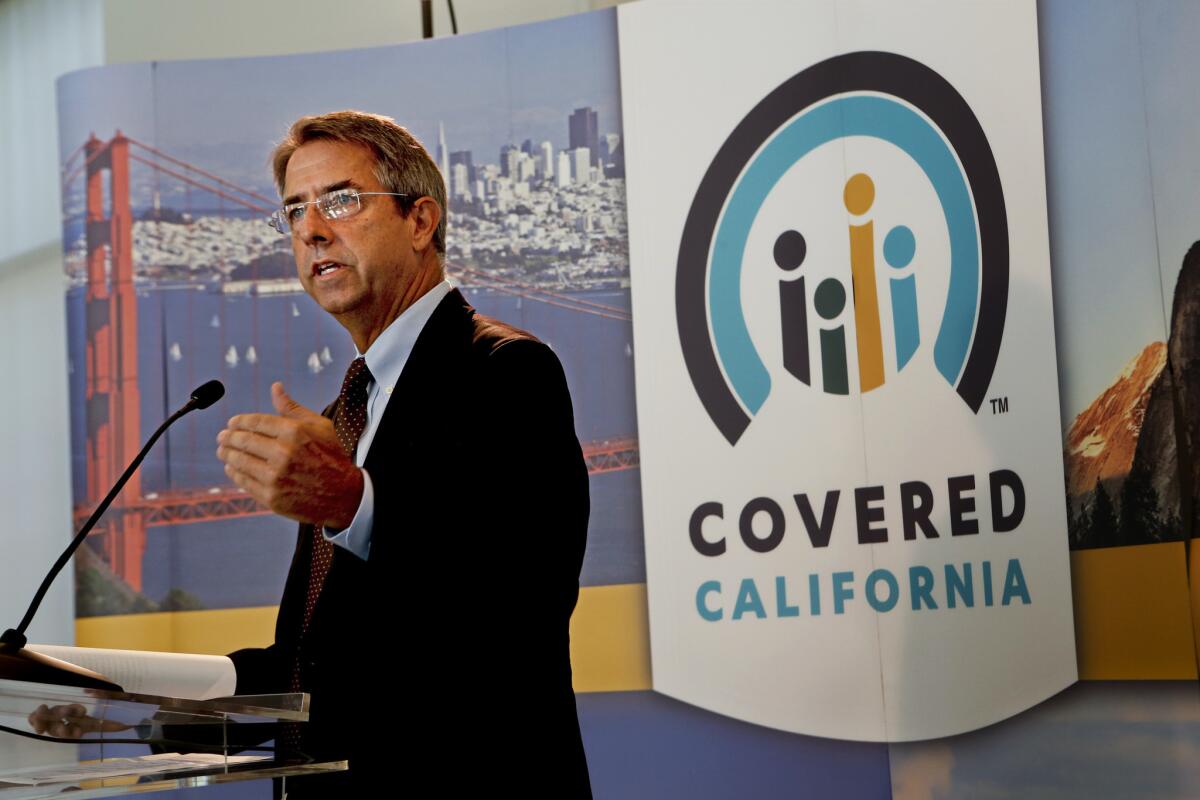Some Californians see health premiums rise sharply as Obamacare enrollment nears

Paula Schwartz of West Los Angeles says Obamacare has helped her afford medical coverage while she cares for her aging mother. But next year, her payments will jump $92 a month, or 57%.
Schwartz, 56, said her new monthly cost of $254 is still about half of what she was paying for coverage before Obamacare. But she worries that those premiums will only continue to rise. Already, she said, the bill has doubled in the program’s first three years.
“Unless there are price controls, we will be back where we were” before the law took effect, Schwartz said.
California has been lauded for creating its own online insurance market, which experts say helped to sharply reduce the share of people without coverage and kept rate hikes lower than elsewhere for the vast majority of policyholders.
Almost 90% of Californians getting insurance from the exchange receive taxpayer-provided assistance to help them afford the premiums.
But as Californians receive their premium rates for next year, some — including those who make too much to qualify for those government subsidies — are learning that their hikes will be far higher than the average statewide increase of 13.2% announced by the state insurance exchange in July.
Open enrollment on the Covered California exchange begins Nov. 1.
Woodland Hills resident Barry Levine, 55, opened a letter from Anthem BlueCross to find that he would be paying 26% more for a policy that provides less coverage. Levine said he is semiretired and living off investment earnings. He doesn’t have access to employer-provided insurance.
His monthly premium is rising from $410 to $517, while the deductibles and co-pays for doctors’ visits are increasing. On top of that, Anthem has changed the plan’s design to a so-called exclusive provider organization, or EPO – which means that it no longer pays even a portion of care received outside the insurer’s network.
“Do I need to wear a necklace that says, ‘Please take me to a BlueCross hospital if I happen to pass out?’” Levine asked. “Every year they cut out things they reimburse for. The value of the benefits is going away.”
Cases of premium sticker shock are happening across the country. This week federal officials said the premium for a mid-level plan on the federal-run exchange used by 39 states will rise an average of 25% next year — nearly double California’s increase.
In the Oct. 24 report, Obama officials said that insurers had underestimated the costs of extending coverage to people with pre-existing conditions — who could be excluded from insurance before the president’s health law passed.
The administration said that even with the large jump in 2017 rates, premiums “will still be roughly in line” with initial projections by the Congressional Budget Office before the law’s passage.
One reason that rates are moderated in California is that more insurers are participating in the state’s exchange, increasing competition and giving consumers more plans to choose from.
State officials say by shopping on the exchange, and switching to a lower-priced plan, most California consumers could pay an increase of just 5% or less this year.
Yet in switching to another plan, many people may have to change doctors and hospitals. They also may get less coverage.
“There will be a time of adjustment,” said Lizelda Lopez, a spokeswoman for Covered California. “All of this will take a lot of time, as a country, to fix.”
Neither Schwartz nor Levine blame their increased costs on President Obama’s law, officially known as the Affordable Care Act. They point out that healthcare costs were soaring even before the law — and that trend has not changed.
Before Obamacare, Schwartz said she was paying premiums of about $500 month and had a much bigger deductible. But she said she worries that her fast-rising payments will soon return to that level.
Levine said before the law was passed, he had many more choices of coverage levels. Now the plans have designs that mirror each other, he said, and his deductible is far higher.
“The cost was already increasing” before the law was passed, Levine said. “It’s very difficult to say whether you are in a better place.”
Gerald Kominski, director of the UCLA Center for Health Policy Research, tied 2017’s higher rates to the phase-out of federal payments that insurers received in the first three years under the law. The payments had helped lower costs for those insurers with the highest medical expenses.
“That’s creating this shock,” Kominski said. “It was anticipated but it doesn’t make it any easier.”
Kominski said that some people may be finding big percentage increases in what they pay monthly because taxpayer-provided subsidies that help them afford their premiums are not going up as fast as some insurers’ costs.
Schwartz’s monthly premium from Blue Shield of California is $696, but subsidies cut her payment to $254. That’s $92 a month more than last year.
On her limited budget, she says the increase will force her to cut back on other expenses.
State officials said anyone concerned about their new rates should go to the online exchange at www.coveredca.com to look at the costs of other plans or talk to a counselor.
But many policyholders are reluctant to change plans because, like Schwartz, they want to keep their doctors.
“I will stay with this plan,” Schwartz said, “and cut back on things like going out to eat.”
This year, Anthem and Blue Shield hiked their rates more dramatically than the state’s other insurers. Blue Shield’s premiums jumped an average of just under 20% statewide, while Anthem’s increased more than 16%.
Insurers raising their premiums have blamed rising overall health costs as well as having too many sick patients compared with those who are healthier and use less medical care.
Stephen Shivinsky, a Blue Shield spokesman, noted that the law also allows insurers to increase rates as a person ages. He encouraged those concerned about increases to call Blue Shield to find out about other options.
Anthem spokesman Darrel Ng said the insurer had to increase rates as it learned more about medical expenses of those enrolled in its Obamacare plans.
“Factors such as increased use of medical services and added costs of drugs and medical therapies put upward pressure on rates,” Ng said, “and underscore the additional work that needs to be done to moderate the growth in healthcare costs.”
Levine has a Bronze plan, which has a $6,800 deductible, up from $6,500 last year. This year, Anthem has ended out-of-network coverage in its Bronze plans, turning them into EPOs, throughout much of the state.
That means Levine will be paying $517 month for a policy he says he may not even use.
“It has turned into a catastrophic policy,” he said, referring to plans intended to only cover large unexpected medical bills.
Ng at Anthem noted that the state requires EPO plans to continue to cover emergency care at any hospital.
In July, Obama administration officials said that national health spending is expected to average more than $10,000 a person this year for the first time in history. By 2025, the administration said, healthcare will represent more than 20% of the economy, up from 17.5% in 2014.
Despite the rising costs, Covered California has worked successfully to greatly reduce the number of uninsured people. Between 2013 and 2015, the share of working-age adults in California without coverage fell from 23.7% to 11.1%, according to federal data. Only three states saw larger declines over the same period.
“We’re proud of what we’ve been able to do in California,” Lopez said.
Follow @melodypetersen on Twitter
ALSO
Soylent halts sales of its powder as customers keep getting sick
NFL stadium promoters confront an expensive question: What if the fans stay away?
The biggest auto-scandal settlement in U.S. history was just approved. VW buybacks start soon
UPDATES:
1:40 p.m.: This article has been updated with additional context about Obamacare premium increases.
This article was originally published at 6 a.m. Oct. 28.
More to Read
Inside the business of entertainment
The Wide Shot brings you news, analysis and insights on everything from streaming wars to production — and what it all means for the future.
You may occasionally receive promotional content from the Los Angeles Times.











